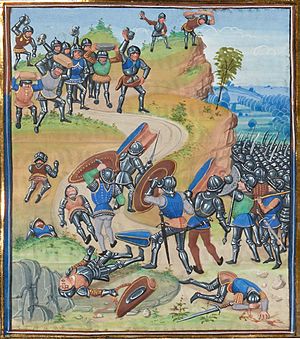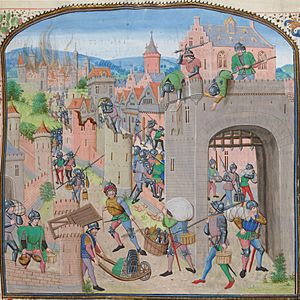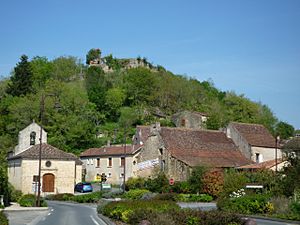Seguin de Badefol facts for kids
Quick facts for kids
Seguin de Badefol
|
|
|---|---|
| Born | 1330 |
| Died | 1366 |
| Battles/wars | Battle of Poitiers |
Seguin de Badefol was a famous leader of a large group of wandering soldiers, sometimes called routiers, during the Middle Ages. These groups were often made up of soldiers who no longer had a job after wars ended. Seguin de Badefol led one of the biggest groups, with about 2,000 fighters. His group was part of a larger collection of these soldiers known as the Tard-Venus.
Contents
Who Was Seguin de Badefol?
Early Life
Seguin de Badefol was born in 1330. His family lived in the castle of Badefols-sur-Dordogne in France. His father was Seguin Gontaut de Badefol, and his mother was Margaret de Bérail. She was the daughter of Arnaud de Cervole. Seguin de Badefol was sometimes called Chopin Badefol.
A Leader of Wandering Soldiers
Seguin de Badefol fought in the Battle of Poitiers in 1356. This was an important battle during the Hundred Years' War. After the Treaty of Brétigny was signed in 1360, many soldiers, including Seguin, were left without work. They formed groups and traveled around.
In 1361, Seguin de Badefol led a group of these fighters. He joined forces with another leader named Bertucat d'Albret. Together, they moved through areas like Languedoc, Roussillon, Toulouse, and Rouergue in France.
Raids and Riches
In 1362, Seguin and Bertucat took control of Montbrun-les-Bains. They also raided the town of Saint-Flour, Cantal. Later that year, Seguin joined Petit Meschin at the Battle of Brignais. They fought against Jacques de Bourbon, who was the Count of La Marche.
In 1363, many of these wandering soldier groups decided to go to Italy. However, Seguin de Badefol chose to stay in France. He continued to raid the Languedoc area with other leaders like Meschin, Louis Rabaud, Arnaud du Solis, and Espiote. On September 13, they took control of Brioude.
In 1364, Seguin's group caused a lot of damage in the region between Lyon and Mâcon. He agreed to leave Clermont-Ferrand on May 21, 1364. But instead of going back to Gascony, he stayed and took control of the Saône and Rhone river regions. He captured sixty castles, including the one in Anse, Rhône in November 1364.
The Pope's Intervention
After eight months of Seguin's group occupying these areas, Pope Urban V became concerned. In July 1365, the Pope gave King John II of France 40,000 florins. This money was meant to pay Seguin's company to leave the kingdom. To make sure Seguin would agree, the Pope held Seguin's father and brothers as hostages in Avignon.
Eventually, the Pope paid the Tard-Venus to leave. Around August 1365, the Pope also officially removed Seguin de Badefol from the church. This was a serious punishment at the time.
Seguin Badefol's troops also raided many other places. These included Puy, Chaise-Dieu in Clermont, Montferrand, Puy-de-Dôme, Chilhac, Riom, Nonnette, Issoire, and Saint-Bonnet Arsis. They caused a lot of damage in the Auvergne region. Finally, after holding Brioude for over a year, Seguin Badefol left the town for a fee. He then went back to Gascony, his home region, with his treasures.
Final Days
In Gascony, Seguin de Badefol was hired by Charles II of Navarre. However, while working for him, Seguin was poisoned. Some say he was poisoned with figs in Pamplona in December 1365. Other historians, like Germain Butaud, believe he was poisoned in Falces in February 1366 after eating quince and pears.




